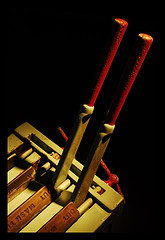Levers Lesson
From WikiEducator
Contents
Finding out about Levers
This lesson is intended to address the BC Grade 5 Physical Science Learning Outcomes but may be adapted to suit a wide range of grade levels from Primary to Intermediate.
Students will be able to
|
Introductory Teaching Notes
The teacher will guide students to discover that a simple machine, i.e. a lever,can make lifting or moving a load easier. A lever is used with a fulcrum, a single point on which the lever rests. Effort is applied to move the load. The fulcrum can be moved to help the lever become more efficient. A teeter-totter is an example of a lever.
Materials
- block of wood
- sandbag or bag of water softening salt
- 2X10 1.5 metres long or other similar board
- ruler for each student
- small wooden block for each student
- numerous coins or weights of equal mass
- student journals for recording observations or scientific procedure sheet to record experiment
Procedure
- Demonstration/Discovery of Lever: Does anyone here think they can lift this bag of sand off the ground without hurting themselves? Choose smallest student in class. Have them try to lift the bag. Other students note the effort exerted in trying to lift the sandbag. Set up lever using board and block of wood with the fulcrum in the middle. Set sandbag on one end of board. Ask student to stand on other end. (Depending on weight of student, you may need to Students observe the effort exerted in lifting the sandbag using the lever and draw conclusion about which is easier.
- Students use rulers, small wooden blocks and coins or weights to make a lever and experiment with moving the fulcrum closer or further from the load at the 15cm, 10cm and 6cm marks. Students record observations in journals or on worksheets. Observations should note that moving the fulcrum closer to the load requires less weight to move the load and vice versa when moving the fulcrum farther away from the load.
- What conclusions can be reached from our experiments today?
- The simple machine we used today to help make the work easier is called a lever. What are the three parts of a lever?
- What are some real life examples of levers?
Extensions
- We learned about a firs class lever today. There are two other types of levers we did not discuss today. They are class 2 where the load is in the middle and class 3 levers where the effort is in the middle. Can you think of examples for a class 2 or class 3 lever? (There are three kinds of levers which differ in the arrangement of the load, effort, and fulcrum. Fulcrum in the middle is a class-1 lever (such as a crowbar). When the load is in the middle, it is a class-2 lever (such as a wheelbarrow). When effort is in the middle, it is a class-3 lever (such as using a broom).)
- Provide a sheet of clipart with the following images - pliers or nutcracker, scissors, hammer pulling a nail, shovel, arm,etc. Students label the fulcrum, load and effort on each.
Return to: Simple Machines
